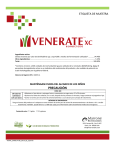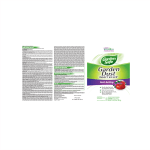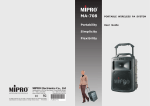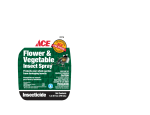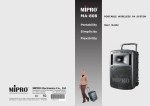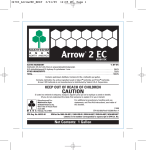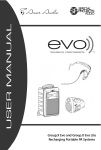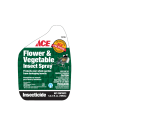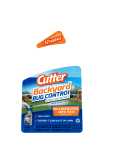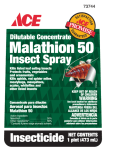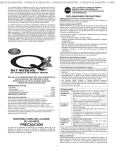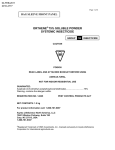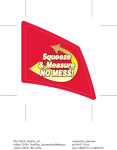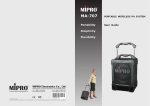Download PRECAUCIÓN - Marrone Bio Innovations
Transcript
ETIQUETA DE MUESTRA Ingrediente activo: T Chromobacterium subtsugae cepa PRAA4-‐1 y medio de fermentación utilizado* ..................................... 30.00% Otros ingredientes: ...................................................................................................................................... 70.00% Total: ........................................................................................................................................................... 100.00% *Contiene al menos 1000 Unidades de mortandad del gusano medidor del repollo (CLKU)/mg. Nota: El porcentaje de ingrediente activo no indicativo del rendimiento del producto y las medidas de potencia no están estandarizadas por el gobierno federal. Número de registro EPA: 84059-‐17 MANTÉNGASE FUERA DEL ALCANCE DE LOS NIÑOS PRECAUCIÓN EN CASO DE CONTACTO CON LOS OJOS: EN CASO DE INHALACIÓN: EN CASO DE INGESTIÓN: EN CASO DE CONTACTO CON LA PIEL O LA ROPA: PRIMEROS AUXILIOS • Mantener el ojo abierto y enjuagar lenta y suavemente con agua entre 15 a 20 minutos. • Quitarse los lentes de contacto, en su caso, después de los primeros 5 minutos y luego continuar enjuagando el ojo. • Llamar al centro para el control de envenenamientos o a un doctor para consejo de tratamiento. • Mover a la persona al aire fresco. • Si la persona no esta respirando, llamar al 911 o la ambulancia, luego suministrar respiración artificial, si es posible preferiblemente de boca a boca. • Llamar a un centro para el control de envenenamientos o a un doctor para mas consejos de tratamiento • Llamar inmediatamente a un centro para el control de envenenamientos o a un doctor para consejo de tratamiento. • Haga que la persona tome sorbos de un vaso con agua, si es que puede tragar. • No inducir el vómito a no ser que lo haya dicho un doctor o el centro para el control de envenenamientos. • No suministrar nada vía oral a una persona inconsciente. • Quitarse la ropa contaminada. • Inmediatamente enjuagarse la piel con suficiente agua durante 15 a 20 minutos. • Llamar a un centro para el control de envenenamientos o a un doctor para consejo de tratamiento. HOT LINE NUMBER Tenga el envase del producto o la etiqueta a mano al llamar al centro para el control de envenenamientos o al doctor o al ir a recibir tratamiento. También puede llamar al 1-‐800-‐222-‐1222 para información sobre tratamiento médico de emergencia. Peso neto: 5 lb 2121 Second St., Ste. B-‐107 Davis, CA 95618 USA [email protected] GRA_13_03_Spanish MEDIDAS PREVETIVAS RIESGO PARA LAS PERSONAS Y LOS ANIMALES DOMÉSTICOS PRECAUCIÓN: Causa irritación moderada en los ojos. Evitar el contacto con los ojos o la ropa. Llevar gafas o lentes de protección. Lavarse bien con agua y jabón después de usar el producto y antes de comer, beber, masticar chicle, usar tabaco o usar el inodoro. Quitarse y labar toda ropa contaminada antes de usarla de nuevo. EQUIPO DE PROTECCION PERSONAL (PPE) Los aplicadores y otros operarios deben llevar puesto: • Camisa de manga larga y pantalones largos • Zapatos y calcetines • Guantes impermeables • Gafas/lentes de protección Todos los operarios deben llevar puesta una máscara de filtro protector contra polvo y rocío que cumpla como mínimo con la normativa NIOSH N-‐95, R-‐95 o P-‐95. La exposición repetifa a altas concentraciones de proteínas microbianas puede causar una sensibilización alérgica. Seguir las instrucciones del fabricante para la limpieza/mantenimiento del PPE. Si no existen tales instrucciones para lavar dicho equipamiento, usar detergente y agua caliente. Mantener y lavar el PPE separadamente de la otra ropa. CONTROLES TÉCNICOS: Cuando los operarios usan sistemas cerrados, cabinas cerradas o aeronaves de una manera que éstos cumplen con los requisitos listados en el Estándar de Protección al Trabajador (WPS) para los pesticidas agrícolas [40 CFR 170.240(d)(4-‐6)], los requisitos referidos al PPE para el operario se pueden reducir o modificar según esté especificado en el WPS. IMPORTANTE: Cuando se opta por reducir el PPE debido a que se está usando un sistema cerrado, se les debe suministrar a los operarios todo el PPE especificado anteriormente para “aplicadores y otros operarios” y tener dicho PPE disponible inmediatamente para su uso en caso de emergencia, como en caso derrame o fallo en el equipo. RECOMENDACIONES DE SEGURIDAD AL USUARIO Los usuarios deben: • Inmediatamente quitarse la ropa si el pesticida penetra. Luego lavarse completamente y ponerse ropa limpia. • Quitarse el PPE inmediatamente después de usar este producto. Lavar la parte exterior de los guantes antes de quitárselos. Tan pronto como sea posible, lavarse completamente y cambiarse a ropa limpia. RIESGO MEDIOAMBIENTAL Este producto es tóxico para invertebrados acuáticos. La deriva del viento y la escorrentía pueden provocar riesgos para los organismos acuáticos de las aguas adyacentes a las zonas tratadas. Este producto es tóxico para ciertos artrópodos terrestres no considerados como plaga. Minimizar la deriva del tratamiendo por el viento para reducir los efectos causados a los insectos no considerados plaga. Para uso terrestre: No aplicar directamente sobre el agua, o en áreas donde haya aguas superficiales, o en áreas por debajo del punto alto donde marca el nivel de las mareas. No contaminar el agua cuando se limpie el equipo o se desechen las aguas del lavado o enjuague del equipo. MODO DE EMPLEO El uso de este producto de manera distinta a lo que se estipula en la etiqueta es un delito contra la Ley Federal. Para cualquier requisito específico dentro de su estado o tribu, consultar con la agencia estatal o tribal responsable de la regulación del uso de pesticidas. No aplicar este producto de ninguna manera que entre en contacto, ya sea directa o indirectamente, con los operarios u otras personas. Sólo los operarios que lleven PPE pueden permanecer en el área de tratamiento. REQUISITOS PARA USO AGRÍCOLA Usar este producto solamente de acuerdo a lo estipulado en su etiqueta y con el Estándar de Protección del Trabajador, 40 CFR sección 170. Esta norma contiene los requisitos para la protección de los trabajadores agrícolas en explotaciones agrícolas, zonas forestales, viveros e invernaderos, y los operarios de pesticidas agrícolas. Contiene los requisitos para la capacitación, descontaminación, notificación, y asistencia de emergencia. También contiene instrucciones y excepciones específicas en esta etiqueta sobre el equipo de protección personal (PPE) y el intervalo de entrada restringida (REI). Los requisitos en este recuadro solamente se refieren a los usos de este producto que están cubiertos por el Estándar de Protección al Trabajador. GRANDEVO Specimen Label 1 No entrar ni permitir la entrada de trabajadores dentro de las áreas tratadas durante el intervalo de entrada restringida (REI) de 4 horas. El PPE necesario para entrar en áreas tratadas antes de lo permitido dentro del Estándar de Protección al Trabajador y que implica el contacto con cualquier cosa que haya sido tratada, como las plantas, tierra o agua es: • Overol/mono de trabajo • Guantes impermeables • Zapatos y calcetines • Gafas/lentes de protección EXCEPCIÓN: Si el producto se incorpora o se injecta en el suelo, el Estándar de Protección del Trabajador permite, bajo ciertas circunstancias, que los operarios accedan a la zona tratada si no van a entrar en contacto con nada que haya sido tratado. REQUISITOS PARA USO NO AGRÍCOLA Los requisitos en este recuadro sólo se refieren a los usos de este producto que no entran dentro del ámbito del Estándar de Protección del Trabajador para pesticidas agrícolas (40 CFR Parte 170). El Estándar de Protección del Trabajador se tiene en cuenta cuando este producto se usa para la producción agrícola vegetal en explotaciones agrícolas, bosques, viveros o invernaderos. Mantener a toda persona sin protección alejada de la zona de tratamiento hasta que éste se haya secado INFORMACIÓN GENERAL GRANDEVO® es un insecticida/acaricida biológico compuesto por los sólifos de fermentación de Chromobacterium subtsugae cepa T PRAA4-‐1 indicado para su uso en cultivos para alimentación contra las plagas enumeradas en la sección MODO DE EMPLEO. GRANDEVO® actúa principalmente como un veneno estomacal para el control o la supresión de muchas plagas que se alimentan de hojas, incluyendo orugas, y ciertos coleópteros. GRANDEVO® actúa de varias maneras contra la plaga, incluyendo la reducción de fecundidad y puesta de huevos, impidiendo la alimentación, y sirviendo como veneno estomacal contra homópteros y hemípteros, como áfidos, psílidos, mosca blanca, chinches y cochinillas, trips y ácaros fitófagos que infestan los cultivos y otras conas de uso listados en la etiqueta. GRANDEVO® debe mezclarse en agua y aplicarse como tratamiento foliar medianto equipos terrestres o aéreos de tratamiento por rocío o como tratamiendo por injección en riego––quimigación. GRANDEVO® se puede usar en campo o invernadero para controlar las plagas enumeradas en la etiqueta. USE INSTRUCTIONS GRANDEVO® is a biological insecticide/miticide for use against listed insects and mites. Close scouting and early attention to infestations is highly recommended. For insects and mites, proper timing of application targeting new populations or recently hatched larvae and nymphs is important for optimal results. Applying GRANDEVO® when pest populations are low is recommended. This product temporarily repels honeybees, for up to 4 to 6 days after spraying. When needed, time applications so that pollination is not disrupted. For insects and mites, thorough coverage of infested plant parts is necessary for effective control. GRANDEVO® does not have systemic activity. For some crops, directed drop nozzles by ground machine are required. Under heavy pest populations, apply a knockdown insecticide prior to or in a tank mix with GRANDEVO®, use the higher label rates, shorten the spray interval, and/or increase the spray volume to improve coverage. Repeat applications at an interval sufficient to maintain control, depending upon plant growth rate, insect and mite activity, and other factors. If attempting to control an insect population with a single application, make the treatment when egg hatch is essentially complete but when larvae or nymphs are young and before economic damage occurs. To enhance control, consider tank mixing with contact insecticides/miticides. Use the lower label rates of GRANDEVO® when populations are low and when tank mixing with other insecticides/miticides. Use the higher rates of GRANDEVO® when applied stand-‐alone, when populations are high or when egg numbers are high. For hard-‐to-‐wet crops, consider using a spreader/sticker or adjuvant, which has been approved for targeted crop use, to enhance coverage and adhesion of GRANDEVO® to the crop. GRANDEVO® has been evaluated for phytotoxicity on a variety of crops under various normal growing conditions. However, testing all crop varieties, in all mixtures and combinations, is not feasible. Prior to treating entire crop, test a small portion of the crop for sensitivity. GRANDEVO Specimen Label 2 GRANDEVO Specimen Label 3 GROUND AND AERIAL APPLICATION Apply GRANDEVO® in ground and aerial equipment with quantities of water sufficient to provide thorough coverage of infested plant parts. The amount of water needed per acre will depend upon crop development, weather, application equipment, and local experience. Do not spray when wind speed favors drift beyond the area intended for use. Avoiding spray drift is the responsibility of the applicator. Mixing directions Important – Do not add GRANDEVO® to the tank mix before introducing 3/4 of the desired amount of water. Add water to mix tank. Start the mechanical or hydraulic agitation to provide moderate circulation before adding GRANDEVO®. Add the desired volume of GRANDEVO® to the mix tank and continue circulation while adding the remainder of the water. Maintain circulation while loading and spraying. Do not mix more GRANDEVO® than can be used in 24 hours. Use a strainer no finer than 50 mesh in conventional spray systems. Spray volume For conventional air and ground applications, use at least 10 gallons of total volume per acre in water-‐based sprays. Tank mixing Do not combine GRANDEVO® in the spray tank with other pesticides, surfactants, adjuvants, or fertilizers if there has been no previous experience or use of the combination to show it is physically compatible, effective, and non-‐injurious under your use conditions. Observe the most restrictive of the labeling limitations and precautions of all products used in mixtures. To ensure compatibility of tank mix combinations, they must be evaluated prior to use. To determine the physical compatibility of this product with other products, use a jar test. Using a quart jar, add the proportionate amounts of the products to one quart of water with agitation. Add dry formulations first, then flowables, and then emulsifiable concentrates last. After thoroughly mixing, let this mixture stand for 5 minutes. If the combination remains mixed or can be readily remixed, it is physically compatible. Once compatibility has been proven, use the same procedure for adding required ingredients to the spray tank. AERIAL DRIFT REDUCTION INFORMATION GENERAL: Avoiding spray drift at the application site is the responsibility of the applicator. The interaction of many equipment and weather-‐related factors determine the potential for spray drift. The applicator and the grower are responsible for considering all these factors when making decisions. Where states have more stringent regulations, they should be observed. Do not apply directly to aquatic habitats (such as, but not limited to, lakes, reservoirs, rivers, streams, marshes, ponds, estuaries, and commercial fish ponds). INFORMATION ON DROPLET SIZE: Use only medium or coarser spray nozzles according to ASAE (S572) definition for standard nozzles. In conditions of low humidity and high temperatures, applicators should use a coarser droplet size. The most effective way to reduce drift potential is to apply large droplets. The best drift management strategy is to apply the largest droplets that will provide sufficient coverage and control. Applying larger droplets reduces drift potential, but will not prevent drift if applications are made improperly, or under unfavorable environmental conditions (see Wind, Temperature and Humidity, and Temperature Inversions). CONTROLLING DROPLET SIZE: Volume – Use high flow rate nozzles to apply the highest practical spray volume. Nozzles with higher rated flows produce larger droplets. Pressure – Do not exceed the nozzle manufacturer's specified pressures. For many nozzle types, lower pressure produces larger droplets. When high flow rates are needed, use higher flow rate nozzles instead of increasing pressure. Number of Nozzles – Use the minimum number of nozzles that provide uniform coverage. Nozzle Orientation – Orienting nozzles so that the spray is released parallel to the airstream produces larger droplets than other orientations and is the recommended practice. Significant deflection from horizontal will reduce droplet size and increase drift potential. Nozzle Type – Use a nozzle type that is designed for the intended application. With most nozzle types, narrower spray angles produce larger droplets. Consider using low-‐drift nozzles. Solid stream nozzles oriented straight back produce the largest droplets and the lowest drift. BOOM WIDTH: For aerial applications, the boom width must not exceed 75% of the wingspan or 90% of the rotary blade. APPLICATION HEIGHT: Do not make applications at a height greater than 10 feet above the top of the largest plants unless a greater height is required for aircraft safety. Making applications at the lowest height that is safe reduces exposure of droplets to evaporation and wind. If application includes a no-‐spray zone, do not release spray at a height greater than 10 feet above the ground or crop canopy. GRANDEVO Specimen Label 4 SWATH ADJUSTMENT: When applications are made with a crosswind, the swath will be displaced downward. Therefore, on the upwind and downwind edges of the field, the applicator must compensate for this displacement by adjusting the path of the aircraft upwind. Swath adjustment distance should increase with increasing drift potential (higher wind, smaller drops, etc.). WIND: Only apply this product if the wind direction favors on-‐target deposition. Do not apply when the wind velocity exceeds 15 mph. Drift potential is lowest between wind speeds of 2–10 mph. However, many factors, including droplet size and equipment type, determine drift potential at any given speed. Application should be avoided below 2 mph due to variable wind direction and high inversion potential. NOTE: Local terrain can influence wind patterns. Every applicator should be familiar with local wind patterns and how they affect spray drift. TEMPERATURE AND HUMIDITY: When making applications in low relative humidity, set up equipment to produce larger droplets to compensate for evaporation. Droplet evaporation is most severe when conditions are both hot and dry. TEMPERATURE INVERSIONS: Do not apply during a temperature inversion because drift potential is high. Temperature inversions restrict vertical air mixing, which causes small, suspended droplets to remain in a concentrated cloud. This cloud can move in unpredictable directions due to the light variable winds common during inversions. Temperature inversions are characterized by increasing temperatures with altitude and are common on nights with limited cloud cover and light to no wind. They begin to form as the sun sets and often continue into the morning. Their presence can be indicated by ground fog; however, if fog is not present, inversions can also be identified by the movement of smoke from a ground source or an aircraft smoke generator. Smoke that layers and moves laterally in a concentrated cloud (under low wind conditions) indicates an inversion, while smoke that moves upward and rapidly dissipates indicates good vertical air mixing. SENSITIVE AREAS: The pesticide should only be applied when the potential for drift to adjacent sensitive areas (e.g. residential areas, bodies of water, known habitat for threatened or endangered species, non-‐target crops) is minimal (e.g. when wind is blowing away from the sensitive areas). Do not allow spray to drift from the application site and contact people, structures people occupy at any time and the associated property, parks and recreation areas, non-‐target crops, aquatic and wetland areas, woodlands, pastures, rangelands, or animals. CHEMIGATION USE DIRECTIONS Spray preparation First, prepare a suspension of GRANDEVO® in a mix tank. Fill tank with ¾ of the amount of water for the area to be treated. Start mechanical or hydraulic agitation. Add the required amount of GRANDEVO®, and then the remaining volume of water. Then, set the sprinkler to deliver a minimum of 0.1 to 0.3 inch of water per acre. Start sprinkler and uniformly inject the suspension of GRANDEVO® into the irrigation water line so as to deliver the desired rate of GRANDEVO® per acre. Inject the suspension of GRANDEVO® with a positive displacement pump into the main line ahead of a right angle turn to ensure adequate mixing. GRANDEVO® is to be metered continuously for the duration of the water application. If you have questions about calibration, you should contact State Extension Service specialists, equipment manufacturers or other experts. Do not combine GRANDEVO® with other pesticides, surfactants, adjuvants, or fertilizers for application through chemigation equipment unless prior experience has shown the combination to be physically compatible, effective and non-‐injurious under your conditions of use. General Requirements -‐ 1) Apply this product only through sprinkler, including center pivot, lateral move, end tow, side (wheel) roll, traveler, big gun, solid set, or hand move irrigation systems. Do not apply this product through any other type of irrigation system. 2) Crop injury, lack of effectiveness, or illegal pesticide residues in the crop can result from non-‐uniform distribution of treated water. 3) If you have questions about calibration, you should contact State Extension Service specialists, equipment manufacturers or other experts. 4) Do not connect an irrigation system (including greenhouse systems) used for pesticide application to a public water system unless the pesticide label-‐prescribed safety devices for public water systems are in place. 5) A person knowledgeable of the chemigation system and responsible for its operation, or under the supervision of the responsible person, shall shut the system down and make necessary adjustments should the need arise. GRANDEVO Specimen Label 5 Specific Requirements for Chemigation Systems Connected to Public Water Systems -‐ 1) Public water system means a system for the provision to the public of piped water for human consumption if such system has at least 15 service connections or regularly serves an average of at least 25 individuals daily at least 60 days out of the year. 2) Chemigation systems connected to public water systems must contain a functional, reduced-‐pressure zone, backflow preventer (RPZ) or the functional equivalent in the water supply line upstream from the point of pesticide introduction. As an option to the RPZ, the water from the public water system should be discharged into a reservoir tank prior to pesticide introduction. There shall be a complete physical break (air gap) between the flow outlet end of the fill pipe and the top or overflow rim of the reservoir tank of at least twice the inside diameter of the fill pipe. 3) The pesticide injection pipeline must contain a functional, automatic, quick-‐closing check valve to prevent the flow of fluid back toward the injection pump. 4) The pesticide injection pipeline must contain a functional, normally closed, solenoid-‐operated valve located on the intake side of the injection pump and connected to the system interlock to prevent fluid from being withdrawn from the supply tank when the irrigation system is either automatically or manually shut down. 5) The system must contain functional interlocking controls to automatically shut off the pesticide injection pump when the water pump motor stops, or in cases where there is no water pump, when the water pressure decreases to the point where pesticide distribution is adversely affected. 6) Systems must use a metering pump, such as a positive displacement injection pump (e.g., diaphragm pump) effectively designed and constructed of materials that are compatible with pesticides and capable of being fitted with a system interlock. 7) Do not apply when wind speed favors drift beyond the area intended for treatment. Specific Requirements for Sprinkler Chemigation -‐ 1) The system must contain a functional check valve, vacuum relief valve and low-‐pressure drain appropriately located on the irrigation pipeline to prevent water source contamination from backflow. 2) The pesticide injection pipeline must contain a functional, automatic, quick-‐closing check valve to prevent the flow of fluid back toward the injection pump. 3) The pesticide injection pipeline must also contain a functional, normally closed, solenoid-‐operated valve located on the intake side of the injection pump and connected to the system interlock to prevent fluid from being withdrawn from the supply tank when the irrigation system is either automatically or manually shut down. 4) The system must contain functional interlocking controls to automatically shut off the pesticide injection pump when the water pump motor stops. 5) The irrigation line or water pump must include a functional pressure switch, which will stop the water pump motor when the water pressure decreases to the point where pesticide distribution is adversely affected. 6) Systems must use a metering pump, such as a positive displacement injection pump (e.g., diaphragm pump) effectively designed and constructed of materials that are compatible with pesticides and capable of being fitted with a system interlock. 7) Do not apply when wind speed favors drift beyond the area intended for treatment. Application Instructions for All Types of Chemigation -‐ 1) Remove scale, pesticide residues, and other foreign matter from the chemical supply tank and entire injector system. Flush with clean water. Failure to provide a clean tank, void of scale or residues, may cause product to lose effectiveness or strength. 2) Determine the treatment rates as indicated in the directions for use and make proper dilutions. 3) Prepare a solution in the chemical tank by filling the tank with the required water and then adding product as required. Utilize agitation to keep solution in suspension. GRANDEVO Specimen Label 6 APPLICATION RATES FOR SELECTED CROPS For greenhouse applications on the crops and pests listed, use 1–3 pounds of GRANDEVO® in 100 gallons of water sprayed until just before point of runoff. See specific application rates for each crop for additional details on greenhouse applications and for all other application types. FOR USE ON THE FOLLOWING CROPS FOR CONTROL OF SPECIFIED INSECTS AND MITES: Pre-‐harvest Interval (PHI) = 0 days Alfalfa (Hay and Seed), Hay and Other Forage Crops 1–3 pounds of GRANDEVO® per acre Alfalfa caterpillar, alfalfa webworm, armyworms, cutworms, European skipper, sod webworm 2–3 pounds of GRANDEVO® per acre Aphids, billbugs, chinch bug, leafhoppers, Lygus, mites (such as clover, Bermuda grass stunt, two-‐spotted, winter grain), plant bugs, spittle bugs Artichoke (Globe) 1–3 pounds of GRANDEVO® per acre Armyworms, artichoke plume moth, loopers 2–3 pounds of GRANDEVO® per acre Aphids, whiteflies Asparagus 2–3 pounds of GRANDEVO® per acre Aphids, armyworms, cutworms Bananas 2–3 pounds of GRANDEVO® per acre Banana skipper Brassica (Cole) Leafy Vegetables Broccoli, Broccoli Raab, Brussels Sprouts, Cabbage, Cauliflower, Cavalo Broccolo, Chinese Broccoli, Chinese Cabbage (Bok Choy), Chinese Cabbage (Napa), Chinese Mustard Cabbage (Gai Choy), Collards, Kale, Kohlrabi, Mizuna, Mustard Greens, Mustard Spinach, and Rape Greens 1–3 pounds of GRANDEVO® per acre Armyworms, beet armyworm, cabbage looper, cabbage webworm, cross-‐striped cabbageworm, cutworms, diamondback moth, imported cabbageworm, light brown apple moth 2–3 pounds of GRANDEVO® per acre Aphids, billbugs, leafhoppers, mites, plant bugs, thrips, whiteflies, yellow margined leaf beetle larvae nd Yellow margined leaf beetle larvae – apply to newly hatched to 2 instar. If adult beetles are also present, tank mix with a knockdown insecticide. Bulb Vegetables Leek, Garlic, Onion (Bulb and Green), and Shallot 1–3 pounds of GRANDEVO® per acre Armyworms, cross-‐striped cabbageworm, cutworms, diamondback moth, European corn borer, green cloverworm, Heliothis, hornworm, imported cabbageworm, leek moth, loopers, omnivorous leafroller, saltmarsh caterpillar, webworms 2–3 pounds of GRANDEVO® per acre Aphids, thrips GRANDEVO Specimen Label 7 Bushberries Blueberry, Currant, Elderberry, Gooseberry, Huckleberry, Juneberry, Lingonberry, and Salal 1–3 pounds of GRANDEVO® per acre Armyworms, cherry fruitworm, cranberry fruitworm, fireworms, leafrollers, loopers 2–3 pounds of GRANDEVO® per acre Aphids, thrips Caneberries Blackberry, Black and Red Raspberry, Loganberry, and Cultivars, Varieties and/or Hybrids of these 1–3 pounds of GRANDEVO® per acre Armyworms, beet armyworm, bertha armyworm, green fruitworm, leafrollers, loopers, western raspberry fruitworm 2–3 pounds of GRANDEVO® per acre Aphids, thrips Cereal Grains Barley, Buckwheat, Oats, Pearl Millet, Proso Millet, Rye, Sorghum (Milo), Triticale, and Wheat 1–3 pounds of GRANDEVO® per acre Armyworms, corn earworm (headworm), southwestern corn borer, web worms 2–3 pounds of GRANDEVO® per acre Aphids (including greenbug), chinch bugs, mites, thrips Citrus Fruit Grapefruit, Lemons, Limes, Oranges, and Tangerines 1–3 pounds of GRANDEVO® per acre Citrus cutworm, citrus leafminer, fruittree leafroller, orangedog 2–3 pounds of GRANDEVO® per acre Asian citrus psyllid, aphids, citrus blackfly, citrus red mite, citrus rust mite, citrus thrips, citrus whitefly, cloudy-‐winged whitefly, glassy-‐winged sharpshooter, mealybugs, six-‐spotted spider mite, Texas citrus mite, two-‐spotted spider mite Corn (Field Corn, Sweet Corn, Popcorn, Corn Grown for Seed) 1–3 pounds of GRANDEVO® per acre Armyworms, common stalk borer, corn earworm, European corn borer, lesser cornstalk borer, southwestern corn borer, webworms, Western bean cutworm 2–3 pounds of GRANDEVO® per acre Chinch bugs, corn leaf aphid, mites, thrips Cotton 1–3 pounds of GRANDEVO® per acre Cotton bollworm, European corn borer, fall armyworm, loopers (soybean and cabbage), saltmarsh caterpillar, tobacco budworm, yellow-‐striped armyworms 2–3 pounds of GRANDEVO® per acre Cotton aphid, cotton leafhopper, leafhoppers, Lygus, mites, silverleaf whitefly, thrips Cranberry 2–3 pounds of GRANDEVO® per acre Aphids, armyworms, brown spanworm, cranberry blossom weevil, cranberry fruitworm, cutworms, fireworms, leafrollers, loopers, mites, sparganothis fruitworm, thrips Do not apply to flooded fields. GRANDEVO Specimen Label 8 Cucurbit Vegetables Cantaloupe, Cucumber, Edible Gourds, Muskmelon, Pumpkin, Watermelon, and Winter and Summer Squash 1–3 pounds of GRANDEVO® per acre Armyworms, cabbage looper, corn earworm, cutworms, melonworm, pickleworm, rindworm complex 2–3 pounds of GRANDEVO® per acre Aphid, mites, thrips, whiteflies Fig 1–3 pounds of GRANDEVO® per acre Navel orangeworm 2–3 pounds of GRANDEVO® per acre Aphids, thrips Fruiting Vegetables Tomato, Pepper, Eggplant, Groundcherry, Pepino, Okra, and Tomatillo 1–3 pounds of GRANDEVO® per acre Armyworms (including beet and yellow-‐striped), European corn borer, hornworms, loopers, saltmarsh caterpillar, tomato fruitworm, tomato pinworm, variegated cutworm 2–3 pounds of GRANDEVO® per acre Aphids, Lygus, mites, pepper weevil, plant bugs, psyllids, thrips, whiteflies Grape, Amur River Grape, Gooseberry, Kiwifruit, Maypop, and Schisandra Berry 1–3 pounds of GRANDEVO® per acre Grape berry moth, grape leaf skeletonizer, grape leafroller, light brown apple moth, oblique-‐banded leafroller, omnivorous leafroller, orange tortrix 2–3 pounds of GRANDEVO® per acre Glassy-‐winged sharpshooter, leafhoppers, mealybugs, mites, Pacific spider mite, thrips, two-‐spotted spider mite, Willamette spider mite, whiteflies Herbs and Spices Angelica, Balm, Basil, Borage, Burnet, Chamomile, Catnip, Chervil, Chive, Clary, Coriander, Costmary, Cilantro, Curry, Dillweed, Horehound, Hyssop, Lavender, Lemongrass, Lovage, Marjoram, Nasturtium, Parsley (Dried), Rosemary, Sage, Savory (Summer and Winter), Sweet Bay, Tansy, Tarragon, Thyme, Wintergreen, Woodruff, and Wormwood 1–3 pounds of GRANDEVO® per acre Armyworm, loopers, saltmarsh caterpillar 2–3 pounds of GRANDEVO® per acre Aphids, mites, thrips, whiteflies Hops and Dried Cones 1–3 pounds of GRANDEVO® per acre Armyworms, loopers 2–3 pounds of GRANDEVO® per acre Hops aphid, mites, thrips, whiteflies GRANDEVO Specimen Label 9 Leafy Vegetables Arugula, Celery, Corn Salad, Cress, Dandelion, Dock, Edible-‐Leaved Chrysanthemum, Endive, Fennel, Head Lettuce, Leaf Lettuce, Parsley, Purslane, Radicchio, Rhubarb, Spinach, and Swiss Chard 1–3 pounds of GRANDEVO® per acre Armyworm, cabbage looper, cutworm species, diamondback moth, green cloverworm, loopers, tobacco budworm 2–3 pounds of GRANDEVO® per acre Aphids, mites, psyllids, thrips, whiteflies Leaves of Root and Tuber Vegetables Beets and Turnips 1–3 pounds of GRANDEVO® per acre Armyworm, cabbage looper, diamondback moth 2–3 pounds of GRANDEVO® per acre Aphids, psyllids, whiteflies Legume Vegetables (Succulent or Dried) and Grain Crops Adzuki Bean, Blackeyed Pea, Beans, Chickpea, Cowpea, Crowder Pea, Edible-‐Pod Pea, English Pea, Fava Bean, Field Bean, Field Pea, Garbanzo Bean, Garden Pea, Green Pea, Kidney Bean, Lentils, Lima Bean, Lupins, Mung Bean, Navy Bean, Peas, Pigeon Pea, Pinto Bean, Runner Bean, Snap Bean, Snow Pea, Soybean, Sugar Snap Pea, Tepary Bean, Wax Bean, and Yardlong Bean 1–3 pounds of GRANDEVO® per acre Armyworms, cabbage looper, corn earworm, green cloverworm, loopers, pod worms, soybean looper, velvet-‐bean caterpillar 2–3 pounds of GRANDEVO® per acre Aphids, kudzu bugs, leafhoppers, mites, thrips, whiteflies Oilseed Crops Canola, Safflower, and Sunflower (including Sunflower Grown for Seed) 1–3 pounds of GRANDEVO® per acre Armyworms, diamondback moth, head worms, Heliothis, loopers, saltmarsh caterpillar 2–3 pounds of GRANDEVO® per acre Aphids, mites, thrips, whiteflies Peanut 1–3 pounds of GRANDEVO® per acre Armyworms, cabbage looper, corn earworm, European corn borer, green cloverworm, pod worms, red-‐necked peanut worm, saltmarsh caterpillar, soybean looper, velvet-‐bean caterpillar 2–3 pounds of GRANDEVO® per acre Aphids, mites, thrips, whiteflies Peppermint 1–3 pounds of GRANDEVO® per acre Armyworms, loopers, saltmarsh caterpillar Pineapple 1–3 pounds of GRANDEVO® per acre Gummosos-‐Batracheda Comosae (Hodges), Thecla-‐Thecla Basilides (Geyr) (Fruitborer) GRANDEVO Specimen Label 10 Pome Fruit Apples, Crabapple, Loquat, Mayhaw, Pears, and Quince 1–3 pounds of GRANDEVO® per acre Codling moth, leafrollers (including fruittree, oblique-‐banded, redbanded, variegated), light brown apple moth, oriental fruit moth, tufted apple budmoth Application timing: optimal timing for codling moth, leafrollers, and oriental fruit moth can vary between species and geographic locations. Monitor moth flights with pheromone traps and scout regularly to determine larval populations. GRANDEVO® can be used to supplement mating disruption programs. 2–3 pounds of GRANDEVO® per acre Aphids, mealybugs, mites, pear psylla, thrips, whiteflies Pomegranate 1–3 pounds of GRANDEVO® per acre Armyworms, cankerworms, codling moth, cutworms, European red mite, filbert leafroller, fruittree leafroller, gypsy moth, McDaniel spider mite, oblique-‐banded leafroller, oriental fruit moth, Pacific spider mite, redbanded leafroller, tufted apple budmoth, twig borer, two-‐spotted red mite, variegated leafroller, walnut caterpillar Root and Tuber Vegetables Black Salsify, Carrot, Cassava, Celeriac, Chayote Root, Chicory, Chinese Artichoke, Edible Burdock, Garden Beet, Ginger, Ginseng, Horseradish, Jerusalem Artichoke, Oriental Radish, Parsnip, Potatoes, Radish, Rutabaga, Salsify, Skirret, Spanish Salsify, Sugar Beet, Sweet Potatoes, Turmeric, Turnip, Turnip Rooted Chervil, Turnip Rooted Parsley, and Yams 1–3 pounds of GRANDEVO® per acre Armyworms, artichoke plume moth, European corn borer, loopers 2–3 pounds of GRANDEVO® per acre Aphids, potato aphid, potato leafhopper, psyllids, whiteflies Stone Fruits Apricots, Cherry, Nectarine, Peach, Plum, Prune 1–3 pounds of GRANDEVO® per acre Green fruitworm, leafrollers (including fruittree, oblique-‐banded, pandemic, redbanded, and variegated), oriental fruit moth, peach twig borer, redhumped caterpillar, tent caterpillar Application timing: optimal timing for leafrollers and peach twig borer can vary between species and geographic locations. Monitor moth flights with pheromone traps and scout regularly to determine larval populations. GRANDEVO® can be used to supplement mating disruption programs. 2–3 pounds of GRANDEVO® per acre Aphids, mealybugs, mites, thrips, whiteflies Strawberry 1–3 pounds of GRANDEVO® per acre Armyworms, cutworms, leafrollers 2–3 pounds of GRANDEVO® per acre Aphids, Lygus, mites, thrips, whiteflies Tobacco 1–3 pounds of GRANDEVO® per acre Hornworms, loopers, tobacco budworm 2–3 pounds of GRANDEVO® per acre Aphids, mites, thrips, whiteflies GRANDEVO Specimen Label 11 Tree Nuts and Pistachios Almond, Cashew, Chestnut, Filbert (Hazelnut), Macadamia, Pecan, Pistachio, Walnut 1–3 pounds of GRANDEVO® per acre Fall webworm, filbert worm, hickory shuckworm, navel orange worm, oblique-‐banded leafroller, peach twig borer, pecan nut casebearer, redhumped caterpillar 2–3 pounds of GRANDEVO® per acre Aphids, mealybugs, mites, pecan weevil, whiteflies Tropical and Subtropical Fruit Acerola, Atemoya, Avocado, Biriba, Black Sapote, Canistel, Cherimoya, Custard Apple, Feijoa, Guava, Ilama, Jaboticaba, Kiwi, Longan, Lychee, Mamey Sapote, Mango, Papaya, Passionfruit, Pulasan, Rambutan, Sapodilla, Soursop, Spanish Lime, Star Apple, Starfruit, Sugar Apple, Ti Palm Leaves, Wax Jambu (Wax Apple), and White Sapote 1–3 pounds of GRANDEVO® per acre Aphids, avocado leafroller, citrus peelminer, cutworms, fruittree leafroller, omnivorous leafroller, orange tortrix, thrips, western tussock moth, whiteflies GRANDEVO Specimen Label 12 STORAGE AND DISPOSAL Do not contaminate water, food or feed by storage and disposal. Pesticide Storage: Store in original container in a cool, dry place. Pesticide Disposal: To avoid wastes, use all material in this container by application according to label directions. If wastes cannot be avoided, offer remaining product to a waste disposal facility or pesticide disposal program (often such programs are run by state or local governments or by industry). Container Handling: Non-‐refillable container. Do not reuse or refill this container. Completely empty bag into application equipment. Then offer for recycling if available, or dispose of empty bag in a sanitary landfill or by incineration. Do not burn, unless allowed by state and local ordinances. (For instances where state and local ordinances do allow burning): If burned, stay out of smoke. WARRANTY To the extent permitted by applicable law, the seller makes no warranty, expressed or implied, of merchantability, fitness or otherwise concerning use of this product. The user assumes all risks of use, storage or handling that are not in strict accordance with the accompanying directions. Label date: May 13, 2013 Made in the U.S.A. US Patents No. 7,244,607 GRANDEVO® is a trademark of Marrone Bio Innovations, Inc. Marrone Bio Innovations' name and logo are registered trademarks of Marrone Bio Innovations, Inc. © Marrone Bio Innovations, Inc. 2121 Second St., Suite B-‐107, Davis, CA 95618 1-‐877-‐664-‐4476 www.marronebio.com [email protected] GRANDEVO Specimen Label 13

















